BETHANY KURZ, Energy & Environmental Research Center; DARREN SCHMIDT, Statoil and PHIL CORTESE, Weatherford International
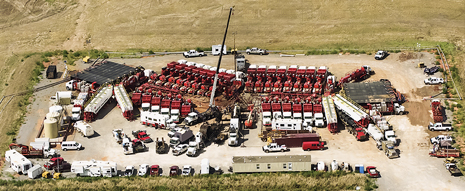 |
| A study of Bakken and Three Forks rock properties and proppant applications has helped improve the understanding of the effects of hydraulic fracturing. |
|
Production from the Bakken and Three Forks formations within the Williston basin is continuing to climb, as a result of horizontal drilling and hydraulic fracturing. One of the keys to increased oil production is the evolution of reservoir stimulation techniques, such as fracturing fluids and proppants. This article describes a study that evaluated the key factors that may result in conductivity loss within the Bakken and Three Forks reservoirs. Various proppants and reservoir rock cores were exposed to common fracturing and formation fluids at reservoir conditions. The results of this study suggest that the conductivity of propped fractures within the Bakken petroleum system appears to be a function of several factors, including proppant and rock strength, as well as formation embedment and spalling. Further understanding can be achieved through advanced conductivity testing, coupled with quantification of formation embedment and spalling.
KEY QUESTIONS
The work discussed herein was developed in an effort to answer questions regarding reservoir stimulation in the Bakken petroleum system, specifically with respect to conductivity loss in hydraulic fractures over time. The key questions that were evaluated include:
- Can conductivity loss be attributed to proppant degradation, rock strength, or both?
- What role do fluids have in affecting propped fracture conductivity?
- To what extent does fluid exposure affect the degradation of rock strength and proppant performance?
- How do various proppants perform, relative to each other, under stress, using actual core samples from the Bakken petroleum system?
LABORATORY TESTS
Laboratory tests were conducted to evaluate the sensitivity of Bakken and Three Forks formation cores to various fluids; to evaluate the strength of several proppant types; and measure the relative laboratory conductivity performance of propped fractures, using actual rock core. Fluids used in experiments to examine potential strength degradation, for both rock and proppant, included the following:
- Slickwater—mixture of polyacrylamide and freshwater
- Cross-linked gel—guar polymer thickening agent, borate crosslinker, and freshwater
- Gelled diesel—diesel fuel and phosphate ester
- Bakken formation crude oil
- Bakken formation brine.
The fluid exposure tests were conducted by immersing the rock and proppant samples in each of the above fluids within 250-mL glass sample containers. The containers were inserted into closed reactors and maintained at 250°F and 3,000 psi for 30 days. Following exposure, tests were completed to examine rock and proppant strength relative to fluid exposure. The exposure studies helped to isolate circumstances that may contribute to a decrease in material strength over time.
FORMATION STRENGTH
Brinell hardness index testing was used to gauge the relative strength of Bakken and Three Forks samples before and after exposure to the aforementioned formation and hydraulic fracturing fluids. Brinell hardness data were available for the Bakken formation from various well files for comparison to the laboratory results. Core samples used to study rock strength originated from the NDIC #16771 well in Manitou field of Mountrail County. Publically available hardness data were available from two wells in proximity, Fig. 1. Brinell hardness for the Upper Bakken shale from the deeper well, NDIC #15986, tended to be softer at the top of the formation (<20) and harder approaching the Middle Bakken. Middle Bakken hardness ranged from 20 to 35. The more shallow well in Williams County had a hardness of <20, with an average of 20 for the Middle Bakken, and a significant variation of strength in the Three Forks ranging from 5 to 30.
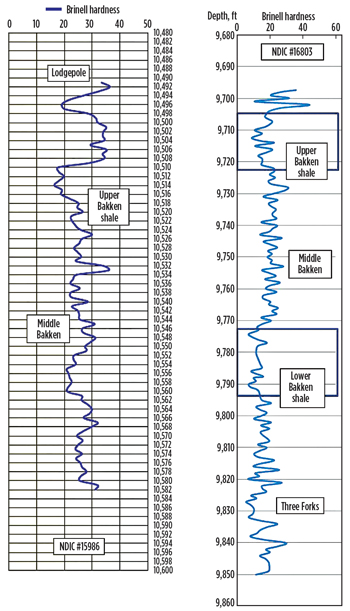 |
| Fig. 1. Brinell hardness data. |
|
The hardness results for core samples from NDIC #16771 are higher in magnitude compared to NDIC #15986 and NDIC #16083. However, the relative nature of the results provides similar characteristics, in that the Lower Bakken shale is soft, Middle Bakken samples are harder, and Three Forks samples are highly variable. Middle Bakken hardness ranges from 40 to 110, Lower Bakken is 30–60, and Three Forks is 40–140. Bakken shale hardness results are generally half the hardness of the Middle Bakken formation, and the Three Forks formation hardness varies significantly.
The difference in magnitude between the well file hardness data and the laboratory results is likely attributable to the constrained nature of the lab sample and the sample orientation during measurement. The indentations of the Brinell hardness tests performed in the lab were perpendicular to the formation bedding planes, whereas the data from the well files were likely generated from penetrations performed parallel to the bedding planes on unconfined whole core. The variation in Brinell hardness in the Three Forks formation is likely a manifest of the properties of the interbedded nature of the green shales and sandstones. Some samples of lower Bakken shale have abnormally high hardness (80–120) as a result of pyrite inclusions. Hardness values relative to pyrite were not used in the analysis of the results.
The Brinell hardness tests of the Middle Bakken formation, Lower Bakken shale, and Three Forks formation samples, after a 30-day exposure to fluids at 250°F and 3,000 psi, are shown in Figs. 2 and 3. For comparison, the figures include the hardness test results of samples that were not exposed to fluids. Middle Bakken samples appeared to experience a general decrease in average strength when exposed to slickwater, cross-linked gel, and formation water. Notably, slickwater had the greatest impact on rock hardness. Lower Bakken shale samples appeared to experience a similar decrease in hardness relative to slickwater and cross-linked gel, with slickwater having the dominant effect. Additional testing was also conducted on wet vs. dry rock; however, there was little difference in the results, suggesting that lower hardness numbers for exposed samples cannot be attributed to the saturated nature of the rock material.
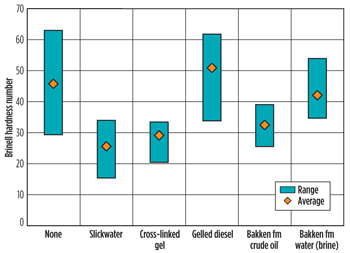 |
| Fig. 2. Brinell hardness for lower Bakken shale samples relative to fluids. |
|
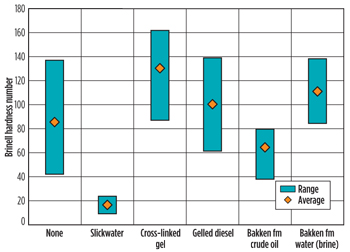 |
| Fig. 3. Brinell hardness for Three Forks samples relative to fluids. |
|
The variability of the Three Forks formation introduces data scatter and difficulty in making a statistically valid conclusion; however, slickwater appears to produce a notable decrease in rock strength for Three Forks samples. In contrast, results from gelled diesel exposure produce average values that are higher than the baseline average, although within limits of measurement variability.
The results of exposing the three rock formation samples to the various fluids and respective hardness testing reveal that the slickwater formulation decreased the strength of the formation face. The corresponding average decrease in Brinell hardness is as follows: 56% for Middle Bakken, 34.1% for Lower Bakken, and 84.3% for Three Forks, suggesting that, on average, the formation face could lose half of its original hardness after exposure to slickwater.
The slickwater formulation for the experiment included 0.75 gal/Mgal of friction reducer (polyacrylamide), 0.5 gal/Mgal of biocide (gluteraldehyde), and 0.5 gal/Mgal of scale inhibitor (phosphonate). The cross-linked gel included 25.1 lb/Mgal of guar, 0.65 gal/Mgal of borate crosslink, 1.5 gal/Mgal of biocide, and 1.5 gal/Mgal of scale inhibitor in the formulation.
Decreases in the strength of the formation face are important, relative to long-term conductivity. Spalling of the formation face in the presence of proppant can produce fines that may contribute to reductions in conductivity. A softer formation face is also more likely to result in proppant embedment.
PROPPANT STRENGTH
To more precisely evaluate proppant strength, a method was devised, based on Ferris (2000), in which the elastic properties of the proppant pack were measured by plotting the stress vs. strain of a proppant pack in a cylinder that is 1 in. in diameter and 0.4 in. deep, loaded at approximately 4 lb/sq ft. This loading density of 20/40 proppant included eight-to-nine layers of proppant stacking. Although not representative of actual proppant loadings in the field of around 1 lb/sq ft, the additional layers ensured the ability of the apparatus to capture the elastic movement of the proppant pack, which can be measured before crush occurs. The characteristics of proppant strain could then be compared in both the elastic and plastic regions of the stress–strain curve to provide a description of the mechanics of the proppant pack as an elastic material.
The stress–strain relationship between sand, RCS and ceramic proppants is shown in Fig. 4. The data include the results from washed proppants. Ceramic proppant displayed a high stiffness, with cleaving beginning to occur in the range of 9,000–10,000 psi. Sand appeared less stiff than ceramic, but more stiff than RCS at less than 7,000 psi. Greater strain was associated with the resin at less than 7,000 psi, when compared to the non-coated sand; however, RCS exhibited good resistance to strain at stresses above 7,000 psi. No noticeable immediate failure was evident with RCS, as compared to ceramic proppant at stresses in the 9,000–10,000-psi range. The relative increase in stiffness at the end of the curve for sand at 9,000 psi is likely due to the consolidation of particles and accompanying reduction of porosity.
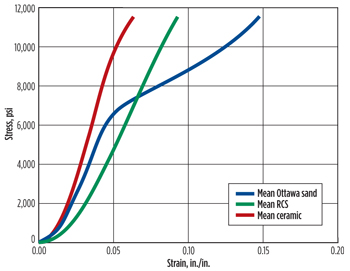 |
| Fig. 4. Stress/strain relationship of sand, RCS and ceramic proppants. |
|
Figures 5–7 provide the elastic–plastic behavior of the proppants that were reacted with fluids for 30 days at 3,000 psi and 250°F, compared to the average elastic–plastic behavior of the unreacted proppant. There was enough proppant from the exposure tests to run two tests for each sample type (an average of the two is presented). The data for the unreacted proppant are an average of five tests of washed proppant. The respective standard deviation of the unreacted proppant tests was plotted to illustrate the uncertainty in the data set and to help determine if the reacted proppant test results were statistically significant.
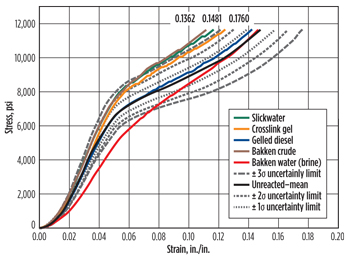 |
| Fig. 5. 20/40 sand reacted proppant compared to unreacted proppant. |
|
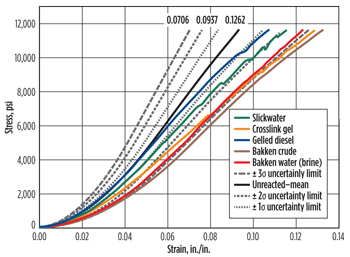 |
| Fig. 6. RCS reacted proppant compared to unreacted proppant. |
|
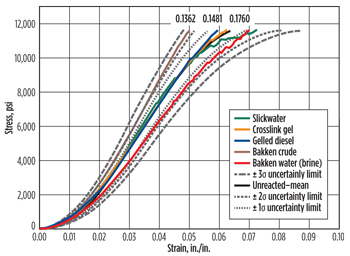 |
| Fig. 7. Ceramic reacted proppant compared to unreacted proppant. |
|
Sand proppants did not appear to exhibit a significant change in elastic behavior relative to the average baseline curve, with the exception of sand exposed to Bakken formation brine. The formation brine concentration was above 250,000 mg/L. The salts likely compromised material stiffness in the elastic range, or salt adhered to the surface permitted more strain to occur at lower stress. Fluids reacted with RCS appeared to produce a decrease in stiffness when compared to the average for the unreacted RCS. Notably, formation water, cross-linked gel and crude had the greatest effect. It appears that resins were affected by fluids and, at high stress, began to produce equivalent strain to that of sand. Fluids reacted with ceramic proppant did not appear to compromise proppant stiffness. Notably, the proppant reacted with formation water tended to have greater strain than the baseline. Collectively, greater strain was a consequence of exposure to formation water. These data are provided in Fig. 8. The greatest difference in strain from the baseline was evident for sand and RCS proppants. Greater strain was associated with RCS as compared to sand. Ceramic and RCS appeared to produce greater strain rates at higher stress, whereas strain at high load for sand did not appear to be related to formation water exposure.
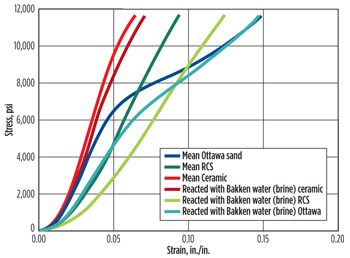 |
| Fig. 8. Comparison of proppants reacted with Bakken formation water relative to proppants that were not reacted with fluids. |
|
CONDUCTIVITY
A standard fracture conductivity test is conducted in an API conductivity cell, in which flow and differential pressure are recorded to determine conductivity under a specified confining load. Standard tests are normally conducted over 50 hours. With the exception of non-Darcy and multiphase flow, likely one of the most significant parameters affecting fracture conductivity is fracture closure pressure. Fracture closure pressure is the pressure required to initiate a hydraulic fracture. The stress on the proppant is closure pressure.
Fracture closure pressures in the Bakken formation can be on the order of 9,500 psi (Terracina and others, 2010) for basin-centered locations and lower in shallower locations. The Elm Coulee field in Montana has been described by Wiley and others (2004) as having fracture gradients of 0.69–0.75 psi/ft, initial pore pressures of 0.5 psi/ft, and bottomhole temperature of 240°F at 10,000 ft. Given the high degree of reservoir pressure variability in the Bakken, a low stress (6,500 psi) and a high stress (8,000 psi) were selected for conductivity testing at a temperature near 200°F. While closure pressures may be greater than 8,000 psi in some locations of the Bakken, the proppant type used in those high-stress conditions would likely be ceramic. The stresses selected for the conductivity testing encompass a broader range of conditions, where other proppant types are likely to be used.
The results of the standard conductivity testing indicate that regardless of rock type, the ceramic proppant exhibited the highest conductivity, followed by RCS and then Ottawa sand, Fig. 9. These results are consistent with the strength tests conducted herein. Very little variance in conductivity was evident between the rock types, despite the higher Brinell hardness associated with the Middle Bakken and Three Forks formations, when compared to the lower Bakken shale. Some variability was evident within the RCS/Three Forks cores; however, the source of the variability was unclear. Approximately a 5.3%, 2.8%, and 4.8% decrease in fracture width was observed respective to the Ottawa sand, RCS, and ceramic proppant. The lower percentage of fracture width loss within the RCS may be indicative of more evenly dispersed loading, as is expected with RCS.
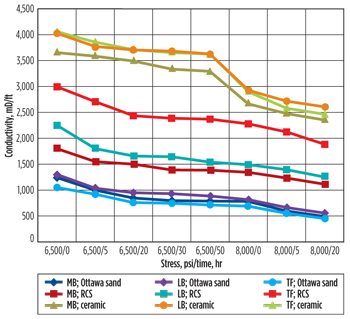 |
| Fig. 9. Conductivity tests using ISO method 13503-5 (MB = Middle Bakken; LB = Lower Bakken; TF = Three Forks). |
|
CONCLUSIONS
Brinell hardness testing of formation core samples after exposure to fluids revealed that slickwater, and cross-linked gel to a lesser extent, consistently decreased the hardness of the formation face for Middle Bakken, Lower Bakken and Three Forks samples. Slickwater produced the greatest decrease in rock hardness and appeared to have less of an impact on the shale than on the other formations (Middle Bakken and Three Forks). The Middle Bakken samples appeared more susceptible to strength loss when exposed to fluids than the other formations. Rocks exposed to gelled diesel experienced very little change in rock hardness.
Proppants exposed to Bakken formation water (brine) consistently experienced the greatest increase in strain relative to proppants that are not exposed. The strength of RCS appeared to be detrimentally affected by all fluids as compared to sand and ceramic. Fluids that have the greatest effect on RCS included cross-linked gel and formation fluids (crude and brine). Crush test results were consistent with elastic strength results for the various proppants and fluids; resin-coated products do not normally produce a large quantity of crushed particles.
All types of proppants have been utilized in the Bakken formation. While anecdotal evidence suggests that sand is an effective proppant in some areas of the Bakken (Williston basin Petroleum Conference, May 2012), the results of this work demonstrated that the ceramic proppant was relatively unreactive and exhibited superior strength characteristics than the other proppant types following fluid exposures. RCS proppants are normally chosen to help prevent proppant flowback. However, these experiments suggest that fluid reactions with resin change the stress–strain relationship for RCS and that fluid considerations are important, relative to the chosen resin.
The examination of the hardness testing, in concert with the proppant strength, revealed that consistency could be found relative to gelled diesel, in that very little effect was evident after exposure to formation rocks and proppants. No particular fluid produced a consistent degradation of both core samples and proppant, although cross-linked gel had a less pronounced detrimental effect on RCS and rock strength.
The results of the conductivity testing demonstrated that at effective stress ranges from 6,500 to 8,000 psi, the ceramic proppant exhibited much higher conductivity than Ottawa sand (as much as five times greater) and moderately higher conductivity than the RCS (as much as 2.3 times greater). Given that the strength of the RCS is affected by reservoir and fracturing fluids, and that slickwater and cross-linked gels have the potential to affect rock strength, advanced conductivity testing using the various fluids would be more representative of actual reservoir conditions. As a follow-up, a Nanovea optical profiler was used to conduct a qualitative evaluation of embedment within the rock slabs used for standard conductivity testing. The results indicated that the Lower Bakken displayed the highest degree of embedment and spalling, followed by the Middle Bakken. Significantly less embedment was evident within the Three Forks cores.
Overall, the results of this study indicated that fluid exposure may affect both rock and proppant strength, and needs to be considered in the field. In addition, conductivity decreases within the Lower and Middle Bakken appear to be a function of a variety of factors, including proppant and rock strength, as well as formation embedment and spalling. Formation embedment and spalling appeared to be less significant within the Three Forks formation. This study also highlights the need for conductivity testing using actual formation and/or fracturing fluids, coupled with quantification of formation embedment and spalling. Given the importance of proppant performance on conductivity loss and, ultimately, oil recovery, a better understanding of the effects of these various factors on proppant and rock strength in the field is vital for more efficient production within unconventional oil and gas reservoirs. 
|
The author
BETHANY KURZ is a Senior Research Manager within the Energy & Environmental Research Center’s (EERC’s) Oil and Gas Research Group. Ms. Kurz’s principal areas of interest and expertise include the evaluation of water supply sources for the oil and gas industry, evaluation of conventional and unconventional materials for use in hydraulic fracturing, produced water management, and characterization of geologic media for carbon storage and/or CO2-based enhanced oil recovery. Ms. Kurz also oversees several of the EERC’s analytical research laboratories. Ms. Kurz received an MS degree in Hydrogeology from the University of North Dakota in 1998 and a BS in Geochemistry from Bridgewater State University, Massachusetts, in 1995. |
ACKNOWLEDGMENT
This material is based upon work supported by the Department of Energy, National Energy Technology Laboratory under Award Number DE-FC26-08NT43291. The authors would like to thank John Kuhlman and Robert Duenckel, Carbo Ceramics; Mike Vincent, Insight Consulting; Ed Murphy and Julie Lefever, North Dakota Geological Survey; and North Dakota Oil and Gas Research Program for support and cooperation. The article is adapted from SPE paper 163849, “Investigation of Improved Conductivity and Proppant Applications in the Bakken Formation” presented by the authors of this article at the SPE Hydraulic Fracturing Technology Conference held in The Woodlands, Texas, Feb. 4-6, 2013.
REFERENCES
1. Ferris, G.W., An Elastic Plastic Approach—Modeling Deformation of Dense Sand, Department of Civil and Geological Engineering, University of Manitoba, Feb. 2000.
2. Fillon, M. 2012, “Bakken Update: The Red Queen Is Just a Fairy Tale,” http://seekingalpha.com/article/906251-bakken-update-the-red-queen-is-just-a-fairy-tale, accessed Oct. 2012.
3. Fjaer, E., Holt, R.M., P. Horsrud, A. M. Raaen and R. Risnes, Petroleum-related rock mechanics, second edition, Elsevier, 2008.
4. Geertsma, J. 1985, “Some rock mechanical aspects of oil and gas well completions,” Society of Petroleum Engineering Journal, 1985, 25, pp 848–856.
5. Gidley, J.L.; S. A. Holditch, D. E. Nierode, D.E., and R. W. Veatch, 1989. Recent Advances in Hydraulic Fracturing. SPE Monograph, Vol. 12, SPE, Richardson, Texas, 1989.
6. Ogden, E., “Future projections for oil, gas-producing counties,” Minot Daily News, Oct. 29, 2012.
7. Palisch, T., R. Duenckel, M. Chapman, S. Woolfolk and M. C. Vincent, M.C., “How to use and misuse proppant crush tests—exposing the Top 10 myths,” paper 119242 presented at the SPE Hydraulic Fracturing Technology Conference, The Woodlands, Texas, Jan. 19-22, 2009.
8. Terracina, J.M., J. M. Turner, D. H. Collins and Spillars, “Proppant selection and its effect on the results of fracturing treatments performed in shale formations,” paper 135502 presented at the SPE Annual Technology Conference and Exhibit, Florence, Italy, Sept. 19-22, 2010.
9. Wiley, C., B. Barree, M. Eberhard, and T. Lantz, “Improved horizontal well stimulations in the Bakken formation, Williston Basin, Montana,” paper 90697 presented at the SPE Annual Technical Conference and Exhibition, Houston, Texas, Sept. 26-29, 2004.
10. Williston Basin Petroleum Conference, Bismarck, North Dakota, May 22–24, 2012.
|












